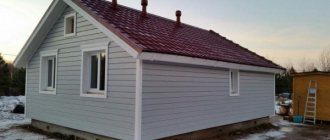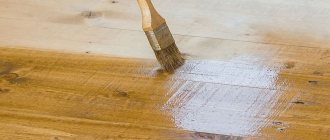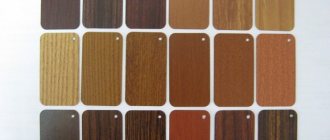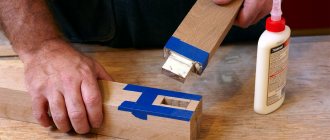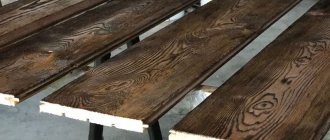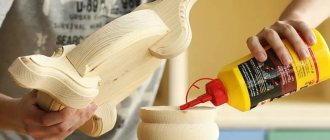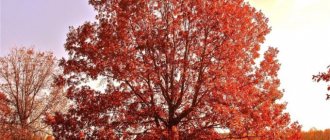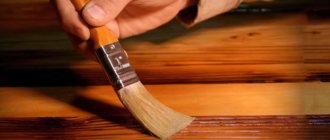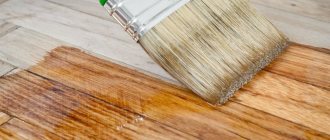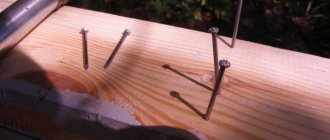Articles
All photos from the article
It is difficult to live without the use of wood in the construction and furnishing of a home. Even if all the supporting structures are made of metal or concrete, finishing materials made of wood will still be used, or the furniture will be made of wood. Today you can purchase almost any wood, including valuable species, so it’s a good idea to understand the color palette.
Different colors of wood
Botanical description
Tectona grandis or in Latin tectona grandis is the well-known teak. It belongs to the Lamiaceae family (lat. Lamiaceae). It is a deciduous tree that can grow up to 40 m tall. The diameter of the trunks reaches 150 cm. The bark is colored silver or gray-brown. The oval-shaped leaves with smooth edges on a thick petiole (2-4 cm) reach 45 cm in length and up to 23 cm in width.
The flowering season begins in June and lasts until August. The inflorescence is a panicle up to 40 cm long, consisting of small white flowers with a strong aroma. The fruits ripen during the autumn months and are round seeds up to 18 mm in diameter. Pollination occurs partly by wind and partly by insects.
Sideboard in the living room
And here is a picture of a room where the sideboard is the only piece made of teak wood. For this material always allows you to feel when its presence should be enormous, and in which cases a little of it is needed. Teak is loved by craftsmen and consumers not only for its beauty, but also for its versatility! (From HomeAdore)
Having a bar like the one in the next photo is wonderful. It is as beautiful as it is functional! On the top cover you can see a combination of chic bottles and funny toys. (By Kai Muller)
Spreading
Teak trees grow naturally in India, Indonesia, Northern Thailand, Northwestern Laos, Malaysia and Myanmar. Monsoon forests are suitable for it, where the soil is well drained and rich in humus. There are several large teak plantations in Panama and Costa Rica.
Trees grown in a natural environment are valued higher. For a hardwood, teak grows quickly. Growth averages up to 1 m per year, but decreases with age. A 20-year-old specimen usually reaches 30 m in height.
Since the culture is quite unpretentious, and many countries have conditions for its cultivation, teak plantings are steadily expanding on the planet. Today, the tree is grown for industrial purposes in Africa, South and Central America.
Teak in the bedroom
Who needs another baby changing table when you have this gorgeous piece of furniture at home, shown in the photo below? It is located in the bedroom, which is an ideal place for night shifts at the bedside of mother and baby. (From Design Mom)
Just seeing this chest of drawers might make you rethink the concept of wardrobes in bedrooms. Your baby will grow up, from infancy to adolescence, surrounded by beautiful things, including this teak miracle! (From A Baby Space)
The next room definitely looks like a multifunctional space, but the bed on the right gives away the fact that this is, indeed, a bedroom. Such a classic piece of furniture in a room full of whimsy and fun touches is just right! (From SF Girl By Bay)
So, you have become familiar with the ideas for using teak furniture in rooms for various purposes. The rest is up to your imagination!
Meaning and Application
Teak wood belongs to class II in terms of wear resistance. If products made from it are used under the roof and are not in contact with dampness, then their service life is unlimited. Teak is resistant to mold and almost does not rot. Wood lends itself well to drying, although it takes longer than, say, pine or larch. Shrinkage is minimal. Once well-dried lumber retains the highest stability of geometric parameters in the future.
In terms of density, teak is inferior to maple and oak, equal to beech and superior to birch (620-750 kg/m3). Its hardness on the Brinell scale reaches 3.6. Cut wood feels a little oily to the touch because it contains a lot of essential oils, which give the characteristic aroma of old natural leather. The wood is strong and dense, resistant to abrasion, withstands the effects of alkalis and acids, and does not stimulate corrosion of metals (nails and screws do not rust in it).
Coloring may vary depending on the location of extraction, age at sawing and the service life of the product. Typically, teak is dark golden in color, has a slightly dull shine when polished and has a beautiful grain texture. The sapwood is not wide, painted white or grayish. When freshly cut, the wood is reddish, but quickly becomes golden or beige with a predominance of brown shades. Products covered with varnish darken over the years, and without a coating they acquire a silver-gray tone under the influence of ultraviolet radiation.
In Southeast Asian countries, teak dust is traditionally used in the production of incense and other incense. Lozenges made from such dust are a common local remedy used in the treatment of tumors and to relieve headaches.
Things made from teak last an exceptionally long time in everyday life; they can be given any design. In many homes in India you will find furniture, dishes, and decorative items that are more than 1000 years old. Due to the high concentration of essential oils in wood, it does not rot even in sea water. This property has been used in shipbuilding for centuries. For example, the steering wheel of the famous cruiser Aurora was made of teak.
In modern woodworking enterprises, teak wood is used in the finishing of large-tonnage ships and private yachts, in the manufacture of furniture, parquet, door and window structures. Chemical resistance allows teak to be made into special furniture used in various laboratories. Resistance to the destructive effects of fungi and mold has made teak wood in demand in the production of garden furniture, decking for terraces, outdoor areas, and swimming pools. High quality plywood is finished with beautiful veneer. If you need to finish a wet room in a house (bathrooms, bathrooms, spas, etc.), then it is extremely difficult to find an alternative to teak in terms of cost, durability and beauty (better is possible, cheaper is not).
For all its valuable qualities, teak is not mahogany. There are rocks that are harder and have brighter colors. Although the annual growth is quite large, specimens that are more than 20-30 years old are of industrial interest. However, the demand for wood is high, and its price is in the upper segment.
Stylish Wonderful teak furniture for every room
A chest of drawers with so many drawers will be useful anywhere! You could say anywhere! Various accessories, such as a mirror on the wall, perfectly complement this piece of furniture. The whole room feels like spring! Have you noticed the fabulous ceiling? (From The Chicer Antiquer)
What kind of room does this short sideboard occupy? Yes, any one you want! A good use for storing utensils in the office (the ability to hide some things behind closed doors is key here). (From Mid-century Modern Freak)
The next photo is a lovely little room, quite special, isn't it? And here we see a teak chest of drawers with drawers and doors, making it an unusually comfortable piece of furniture. (From Mustard Vintage)
Wooden furniture in the interior
Wood, like no other artificial material, fills a home with genuine natural energy. When you touch it, you feel the warmth, and when you look at the annual rings, you go back in time.
Therefore, it does not seem at all strange that such a passion for furniture made of wood, solid, archaic, antique - it all depends on the capabilities and preferences of the customer. Leading designers around the world prefer furniture that was cut from solid tree trunks, with obvious cracks and knots.
Often, objects that already resemble peasant furniture become discolored and take on a dilapidated appearance.
Tonino Guerra, a famous screenwriter and poet, was famous for another talent - he created furniture from his own sketches. But the main materials for its manufacture were old boards, door hinges and locks found in their native medieval town.
Then the created elements were assembled piece by piece into pieces of furniture or decorative compositions.
When creating rough furniture, designers set themselves the goal of showing its originality and history. For example, they use the stumps of old trees, remove the bark from them and create unusual interior items. And in combination with leather furniture and some attributes they create an unsurpassed effect.
Combination with stone and brick
Combination with different materials in the interior: glass, stone, plastic, gives a different end result, but what remains the same is that wood is a universal and popular finish.
Stone and wood in the interior as two natural materials complement each other. Warm and soft wood with strong stone are indispensable for creating eco, Provence and country style. Pebble mosaics and plank floors, decorative stone fragments, parquet boards and beams combine perfectly and are suitable for any interior.
Brick and wood in the interior or imitation brickwork is suitable for the corridor, living room, stairs.
Brick can be bleached, aged, plain or of different sizes; such variations create a different image of the room. The use of wood in an interior with brick is necessary to create an unusual design for a country house: wooden frames and doors, stairs, partitions and redwood floors in combination with antique chests of drawers.
Who prefers to use wood in the interior?
It is an undeniable fact that wood was, is and will be a favorite of sophisticated, refined people who value luxury combined with naturalness. The tree will also be appreciated by people for whom family, warmth and comfort are the main values in life.
Wood is the preference of people with good taste and clear life positions.
Thus, wood in the interior offers endless possibilities that come down to environmental friendliness, practicality and sophistication. It can be used to create any design in which an atmosphere of peace, warmth and natural richness is sure to reign.
Interior design rules
If you decide to decorate the interior yourself, including various wooden coverings, you need to adhere to the basic rules:
- Three shades. Excessive use of wood in decoration can lead to negative consequences. It is better not to combine more than three wood tones in one room, otherwise the decor will lose its harmony. The combination of mismatched sets and products with completely incompatible textures looks especially unattractive.
- Accents. Materials of contrasting shades can look good in one interior. Also attractive will be a modest setting, diluted with “wood accents” - unusual parquet, ceiling beams, panels, non-standard furniture.
- Single range. No less delicate and stylish in appearance is the room, in which several components are decorated in similar shades of natural wood. This design is neutral in perception and does not have a negative impact on mood. However, all colors should be independent, and not differ by just half a tone.
- Lighting. The quality and quantity of light in a room is of direct importance for the correct assessment of a particular shade. If the room is located on the north side and there is little natural light in it, you should abandon non-contrast combinations. The transition between similar shades will be simply unnoticeable. Warm wood tones look more interesting with yellowish lamps.
Which wood stain is better: photos of colors and palettes of different compositions
Stain allows you to refresh an old interior and transform the appearance of your home, both inside and outside. There is no need to buy new furniture or replace doors and windows. It is enough to apply a decorative coating to a previously prepared wood surface.
When choosing a high-quality stain, you can be sure that it will protect the wood from excess moisture and negative external influences
Stain, unlike paint, forms a transparent layer on the surface. It penetrates deep into the wood, giving the material the necessary shade, which can vary from walnut to mahogany and mahogany. If you look at a surface treated with a tinting composition, the color result can easily be confused with a natural color. You may get the impression that the tree is in its original form.
Cultivation [edit | edit code]
The bulk of the teak wood on the market comes from teak plantations located in Indonesia and controlled by Perum Perhutani (the state-owned forestry company), which manages the country's forests. The main use of teak wood harvested in Indonesia is the production of teak furniture for export [8].
The increasing consumption of teak has caused an increase in related problems such as the disappearance of old teak trees. However, its popularity has led to a steady increase in teak plantation cultivation in areas with seasonally dry tropical climates. The Forest Stewardship Council issues certificates for products made from plantation-grown teak. It is economically profitable to propagate teak for plantation purposes using tissue culture [9].
The bulk of teak in the world is exported from Indonesia and Myanmar. Plantations are also developing rapidly in Central (Costa Rica) and South America.
Reproduction [edit | edit code ]
Most often, teak is propagated using seeds. For germination, seeds require pre-treatment, which consists of destroying the thick pericarp. In addition, soaking and drying the seeds is used. The seeds are immersed in water for 12 hours and then dried in the sun for 12 hours. The procedure is repeated for 10-14 days, and then the seeds are sown in small germination containers filled with coarse peat sprinkled with sand. After this, germination occurs within 15-30 days [10] [11].
Pests [edit | edit code]
Teak wood is quite resistant to damaging factors, both biological and extra-biological.
Caterpillars of various butterflies can cause some damage by eating teak leaves, and the tree can also be infested by various semi-parasitic species of the genus Limegrass. Hyblaea puera
, an insect native to Southeast Asia, is a pest of teak, with its caterpillars feeding on teak and other tree species native to the region [7]
The heartwood of a tree is attacked only occasionally, for example by wood borers ( Xyleutes ceramicus
) and fungal pathogens of heart rot.
Phytopathogenic viruses and bacteria infect these trees very rarely. The main causative agents of fungal diseases are: Armillaria mellea
,
Fomes lignosus
,
Fomes noxius
,
Heterobasidium compactum
,
Irpex flavus
, species of the genus
Nectria
,
Olivea tectonae
("teak leaf rust"),
Peniophora rhizomorpha
("yellow layer rot") and
Polyporus zonalis
("white sac rot").
In plantations, damage may occur due to trampling or stripping of trees by elephants. Teak wood is relatively resistant to fire.
About painting technology
In addition to the correct choice of paint color for wood, painting technology is of great importance. Only in this case the paint will not peel off several months after painting.
Choosing color and painting wood
When painting externally and internally, you will have to choose between glazing and covering compounds. The former protect the wood from moisture and insects, but the texture remains visible. As for covering compounds, they form an opaque layer on the surface.
The choice of paint color depends on many factors; when painting surfaces inside the house, the color scheme of wood paints is selected taking into account the overall design of the room. For example, when decorating the kitchen of a timber house in the Provence style, preference is given to light shades, but dark shades (mahogany, ebony, wenge, etc.) are not used at all.
In the photo - a kitchen in Provence style
When painting the exterior of a house, there are more options, such as:
- light, calm colors (beige, white, etc.). Finnish houses are usually decorated in exactly this color scheme;
Note! When using light shades, you can combine it with dark inserts. This will make the house look more impressive.
- it is allowed to use rich shades, for example, the color of teak wood will give a reddish tint after painting;
- You can use other shades, for example, green. You just need to take into account that the paint consumption should be higher so that the wood texture does not show through.
Greenish tint of the house
Also, when choosing the color of wooden houses, you should take into account the surrounding environment. If the colors of neighboring buildings are in calm, light colors, then it makes sense to choose the same shade. In this case, using bright colors will be unnecessary; the house will simply look ridiculous against the background of its neighbors.
As for painting wood with your own hands, when doing exterior work you should adhere to the following recommendations:
- do not quit work halfway, then the border between areas will be noticeable;
- paint under normal conditions - low humidity, direct sunlight does not fall on the paint;
- Before applying the next layer, wait for the previous one to dry.
It's better to paint the whole house at once
When working inside the house, the instructions require:
- provide good ventilation;
- thoroughly sand the surface before painting;
- in order to prevent the paint from being absorbed into the wood, it must first be primed;
- To obtain an even, rich color, 3 or more layers of paint may be needed. The drying time for each layer depends on the type of paint.
It is important to understand that the final result largely depends on the type of surface. For example, the color walnut applied to a board with an expressive texture in 1 layer will give an interesting effect - the texture of the wood will be visible, so it will seem that the board is really made of walnut. But if you apply paint to a sheet of chipboard, you will get a solid, even color.
Experiments with paint
Sometimes the desired effect cannot be achieved by simply painting or applying varnish to a wooden surface. In this case, you have to experiment and combine different compositions.
Note! It is advisable to carry out experiments on an unnecessary piece of wood. Otherwise, the price of such creativity will be too high.
This technique is often used when it is necessary to age wood or achieve the effect of bleached wood.
To get the desired effect you need:
- first brush the wooden surface with a wire brush to remove soft wood fibers;
Removing soft fibers
- clean the surface of small sawdust;
- then the fun begins - apply 1 thin layer of light paint, wait until it dries;
- protruding hard fibers will remain unpainted, imitating an old surface. A couple of layers of varnish can be applied on top to protect the surface from abrasion and fading.
A combination of shades for the same purpose is also possible. This does not mean mixing different colors, but sequential coloring in different shades. Any colors of wood paints can be combined in this way, the main thing is to ensure that one shows through from under the other, creating the illusion of wear and tear received over years of use.
About the color scheme
More than a dozen shades can be distinguished, and the name of the corresponding wood species is used to designate each of them. For example, the color of mahogany wood means a reddish-brown hue. Over time, mahogany wood itself acquires a richer color and becomes even more beautiful.
This is what mahogany wood looks like
Ordinary cherry is quite close to mahogany; depending on the age of the wood and growing conditions, the wood can have a shade from dark red to light with golden. So the color of cherry wood is often confused with mahogany.
Cherry can resemble mahogany
Wood itself has an excellent appearance, so often when processing it is enough to simply reveal the texture and protect the surface from fading, although no one has canceled paint treatment. Sometimes this can be used to achieve a great visual effect.
When choosing a suitable shade, you need to understand that even within the same color there are a lot of shades.
In addition, they may differ depending on the manufacturer:
- for example, the color of walnut wood in the case of a parquet board involves a change in shade from beige to “black coffee”. But when designating paint, this designation refers to a rich brown shade;
- under the designation “pine” in the palette there is a rich yellowish color;
Note! There may be designations “young pine” - a lighter color and “old pine” - richer and slightly darker.
- but under the designation “mahogany” lies a rich paint with a dark red tint. The wood of this species has exactly this shade, hence the name;
- Wenge color is also popular in finishing; this wood is rich in richness, but falls a little short of complete blackness and upon closer examination the original texture is visible. Paint, of course, will not give such an effect, but in shade it is very close to this wood;
- The color ebony is as close as possible to pure black. Ebony wood can be either jet black or deep gray in color, depending on the age and how close to the core of the trunk the sample was taken. The shades of paint in this case range from rich gray to almost black.
When choosing paint materials, you need to understand that it is not at all necessary to paint the surface until a monochromatic surface is obtained. Sometimes it is much better to simply emphasize the texture, perhaps tint the surface, but not completely paint over it
Sometimes it's better to just show the texture
Decor made of wooden elements
Due to their strength and unusual beauty, wooden ends have long been popular among craftsmen. Each layer stores history, mood and nature. In addition to all this, material for the ends surrounds us everywhere; crooked branches, thickenings on tree trunks, cracks, knots, etc. become especially interesting. You just have to give free rein to your imagination and emotions.
Decorative lamps, vases, hangers, tables made of wood elements are very relevant today. They, in combination with modern design solutions, are able to fill the atmosphere of the home with comfort, luxury and warmth at the same time.
Dead stumps, branches, trunks and roots in the hands of an artist can become a masterpiece that will decorate the interior, filling it with natural simplicity and harmony.
Tree in the nursery
This material in the interior of a nursery is most appropriate from an environmental point of view. It is advisable to use wood both for decoration and decoration. If the walls do not necessarily have to be wooden, then the floor and furniture simply need to be selected from wood materials.
A light laminate floor will be decorated with a homemade drawn carpet; to develop the child’s mobility, you can hang a hammock and a rope ladder.
For an unusual look, you can use branches in the interior to create small compositions, an organizer for jewelry, photos and notes; they can also be used to decorate wall shelves.
Light colors, delicate textiles, bright toys and dark floors are suitable for decorating a nursery for both girls and boys.

